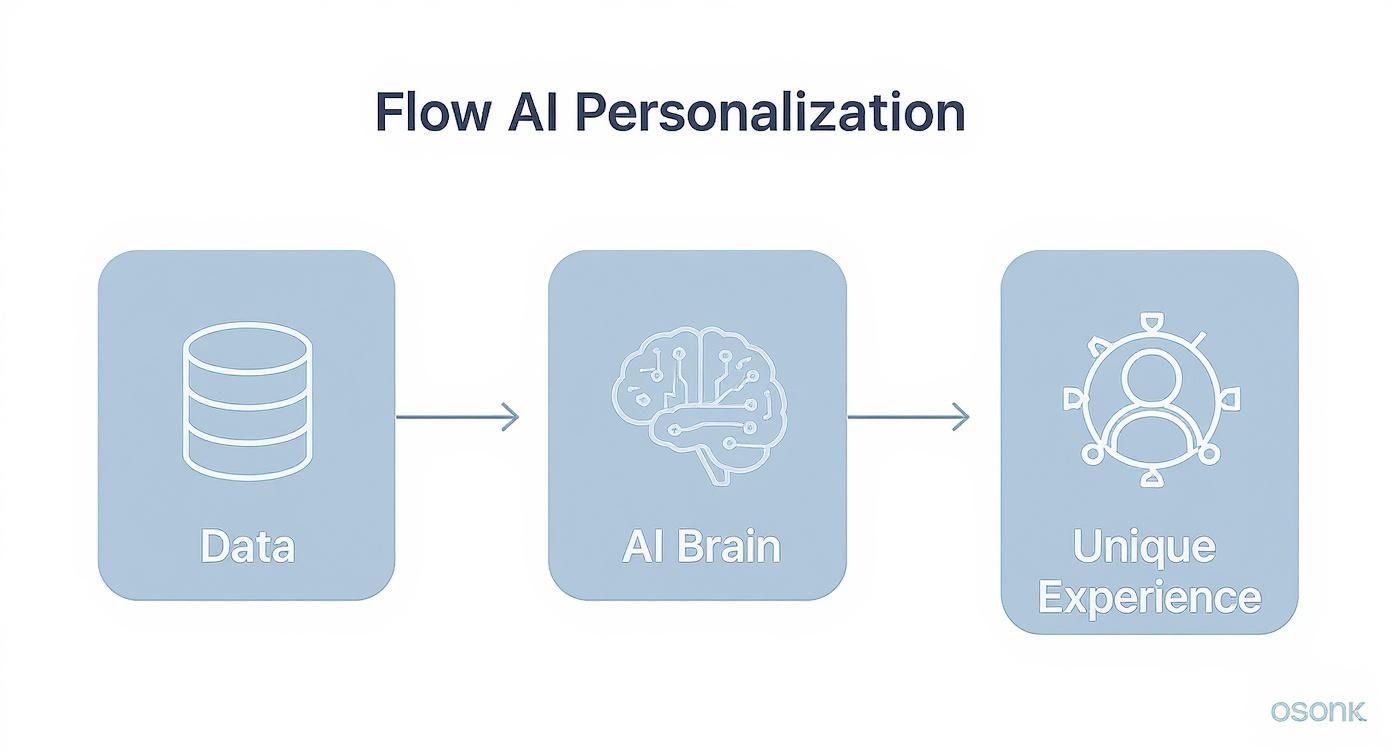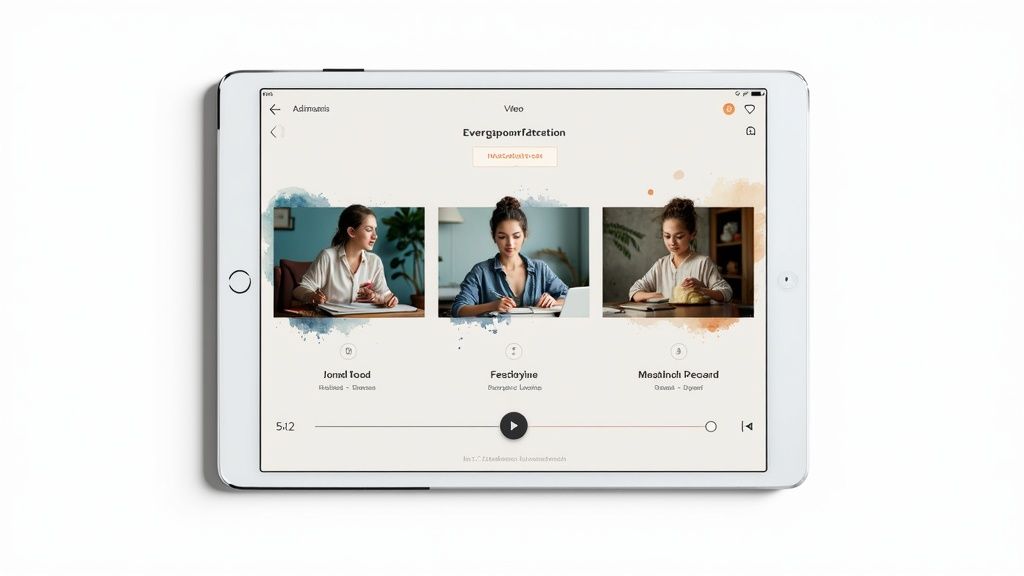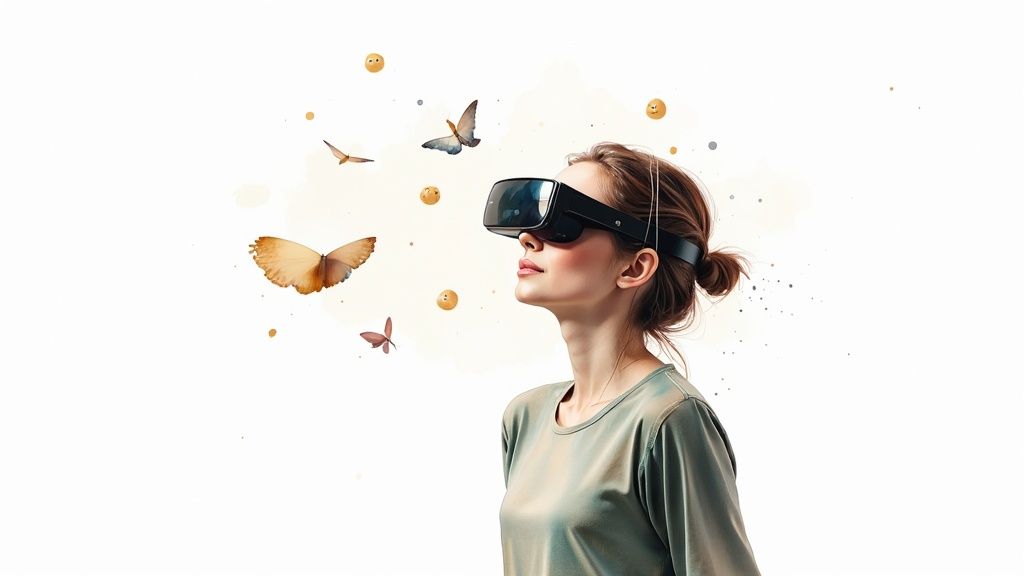Discover artificial intelligence personalization and how it shapes smarter experiences with tailored content and recommendations. Click to learn more.
In This Article
Subscribe to our newsletter
When you hear “personalization,” you might think of an email with your name at the top. But artificial intelligence personalization goes so much deeper. It’s about using AI to deliver highly specific and relevant experiences to each person, in real time. Instead of serving up the same generic content for everyone, this technology digs into user data to figure out what each individual wants to see next, creating a unique one-to-one interaction, but at massive scale.
What Is AI Personalization?
Think about your favorite local coffee shop. You walk in, and the barista already knows your name and your usual—an oat milk latte, extra shot. They might even ask how that big project you mentioned last week is going. That interaction feels good because it’s personal; it’s built on recognition and shared history.
Artificial intelligence personalization is all about creating that same feeling for every single user on a digital platform. It’s like having a virtual concierge for millions of people at once.
This isn’t just about surface-level tricks. It's a dynamic process where machine learning algorithms constantly sift through huge amounts of data to understand individual behaviors, preferences, and what’s happening in the moment. These algorithms learn from every click, search, and video watched. For a great primer on the concept, check out this helpful resource on artificial intelligence personalization.
The Core Components of Personalization
So, how does this actually work? To pull off this kind of customization, AI systems need a few key pieces working together. These are the building blocks that turn raw data into a truly unique user journey.
- Data Collection: First, the AI gathers information from all over—browsing history, past purchases, time spent on a page, even basic demographic details.
- Data Analysis: Next, machine learning models get to work, processing all that information to spot patterns and predict what a user might do next.
- Content Delivery: Finally, the system acts on those predictions, serving up customized content like recommended products, tailored video thumbnails, or a personalized news feed.
It's a continuous loop. The system is always collecting, analyzing, and delivering, getting smarter and more refined with every single interaction.
At its core, AI personalization transforms data from a simple record of past actions into a predictive tool for future engagement. It's about moving from reacting to user behavior to anticipating it before it even happens.
For publishers, this is a game-changer for video. Instead of a one-size-fits-all video feed, AI can dynamically adjust recommendations on the fly. This ensures viewers see content that actually aligns with what they’re interested in at that exact moment.
The result? Longer watch times, higher engagement, and a more loyal audience. It just goes to show that a personal touch—even one driven by algorithms—makes all the difference.
How AI Personalization Engines Actually Work
To really get what’s going on inside an artificial intelligence personalization engine, picture a master chef who crafts a unique dish for every single customer walking through the door. This isn't about one recipe for everyone. It's about a bespoke experience, made from scratch with the best ingredients and techniques. The real magic happens behind the scenes, turning raw data into a perfectly prepared final product.
At the center of it all are two key parts: the ingredients (that’s the user data) and the recipes (the machine learning algorithms). Even the world's best chef can’t do much with poor ingredients. In the same way, data is just a pile of useless facts without sophisticated recipes to bring it to life.
The Ingredients Fueling Personalization
Everything starts with collecting a rich variety of user data. Think of this as the pantry of flavors and textures the AI needs to understand who it's "cooking" for.
- Demographic Data: The basics, like age, gender, and location. This gives the AI a general idea of the user segment it's dealing with.
- Behavioral Data: This is the most important ingredient by far. It tracks what people actually do—which pages they browse, what videos they watch, the products they click, and how long they stick around.
- Contextual Data: This is real-time information, like the device someone's using, the time of day, or even the weather. A person watching videos on their phone during a morning commute has very different needs than someone browsing on a desktop computer at home.
This concept map helps visualize how these raw ingredients are whipped up by an AI engine to serve a one-of-a-kind user experience.

As you can see, it's a direct path from data collection to a personalized result, with the AI acting as the central brain that processes all the inputs to create a very specific output.
The Recipes That Create the Experience
Once the ingredients are in the kitchen, the machine learning algorithms—the chef's secret recipes—get to work. These algorithms are really just sets of rules and statistical models that dig into the data to make surprisingly accurate predictions.
The AI doesn't just look at one user by themselves. It compares one person's behavior to millions of others, finding subtle patterns and connections you’d never spot on your own. This uncanny ability to predict what a user wants next is what makes AI personalization so powerful and valuable. It’s no wonder the market for this tech is exploding.
The AI-driven personalized recommendations market is on a massive growth trajectory, projected to jump from USD 1.84 billion to USD 24.8 billion by 2034. That's a staggering CAGR of 29.7%. North America is leading the charge, holding over 32.8% of the market. You can dive deeper into the growth of the AI recommendation market to see the full picture.
Just like a chef uses different cooking methods for different dishes, AI engines use different algorithms for different goals. A couple of common ones are collaborative filtering, which suggests things based on what similar users liked, and reinforcement learning, where the AI learns by testing different recommendations to see what works best.
Each technique has its own strengths. Recommending the next video in a playlist is a different challenge than personalizing an entire homepage, and you need the right tool for the job.
The table below breaks down a few of the most common AI personalization techniques and where they shine.
Comparing AI Personalization Techniques
This table gives a quick look at the "recipes" that power modern recommendation engines.
| Technique | How It Works | Best For |
|---|---|---|
| Collaborative Filtering | Analyzes the behavior of similar users to make predictions ("People who watched A also watched B"). | Recommending products, articles, or videos based on community trends and popular choices. |
| Content-Based Filtering | Recommends items based on their attributes and a user's past preferences for those attributes. | Suggesting content similar to what a user has already engaged with, like recommending sci-fi movies to a sci-fi fan. |
| Reinforcement Learning | The AI learns through continuous feedback, optimizing for a specific goal like maximizing watch time or click-through rates. | Dynamically adjusting user interfaces, personalizing video thumbnails, or optimizing ad placements in real time. |
| Predictive Analytics | Uses historical data and statistical models to forecast future behavior, such as identifying users at risk of churning. | Proactive customer retention, personalizing marketing campaigns, and forecasting demand for specific content. |
By blending these powerful "recipes" with rich data "ingredients," artificial intelligence personalization engines cook up experiences that feel like they were made just for you—a huge step up from the old one-size-fits-all approach.
The Real Business Impact of AI Personalization
It’s one thing to understand the mechanics of artificial intelligence personalization, but it's another thing entirely to see how that tech translates into real, measurable business growth. Once you get past the technical jargon, the "why" behind this investment is refreshingly simple: it has a direct and powerful impact on the bottom line. A well-executed personalization strategy isn't just a nice-to-have; it delivers tangible results that forge stronger customer relationships and drive revenue.
At its heart, the biggest benefit is a fundamental shift in communication. Instead of broadcasting a single, generic message to your entire audience, you’re suddenly able to have millions of individual conversations at once. This makes people feel seen and understood, which is the magic ingredient for boosting engagement, building loyalty, and ultimately, getting more conversions. When content feels like it was hand-picked just for you, you’re far more likely to click, watch, and buy.
Boosting Conversions and Revenue
One of the first places you’ll see the impact of AI personalization is a serious lift in conversion rates. By showing users the most relevant content or products at just the right moment, you're essentially removing all the friction from their journey. This is a game-changer for publishers who use video to drive e-commerce sales.
Imagine an online media brand that reviews tech gadgets. Instead of showing every single visitor the same "Top 10 Laptops" video, an AI can step in. It analyzes a user's browsing history and notices they’ve been reading articles about portable editing machines. In a split second, the system automatically surfaces a video review of a lightweight, powerful laptop perfect for video editors, complete with a direct link to purchase.
This kind of targeted approach leads to a domino effect:
- Higher Click-Through Rates: The video thumbnail and title are so relevant that clicking becomes a no-brainer.
- Increased Average Order Value (AOV): The AI can then recommend compatible accessories, like a portable SSD or a high-res monitor, right there with the video.
- Improved Sales Conversion: The user is guided smoothly from interest to purchase without ever hitting a dead end or an irrelevant piece of content.
This isn’t just a nice theory. Businesses across every sector are seeing these kinds of results, which is fueling massive investment in personalization technology. The market is huge and growing fast as more companies connect the dots between personalization and financial performance.
Deepening Engagement and Slashing Churn
Beyond the quick wins in sales, AI personalization is your best weapon for building long-term relationships. In today’s crowded digital world, a user's attention is the most valuable currency you have. Personalized content makes your platform "stickier," giving people a reason to stay longer and come back more often.
Just think about a streaming service. Its biggest enemy is churn—subscribers who cancel their service. A generic homepage showing the same featured content to everyone is a recipe for boredom and disengagement. But an AI-powered platform learns from what you watch.
An effective AI personalization engine doesn't just recommend what's popular; it predicts what will delight a specific individual, transforming a passive viewer into an active, loyal subscriber.
If you watch a lot of historical documentaries, the AI makes sure your feed is filled with similar content, new releases in that genre, and even curated playlists. This simple act of recognition makes the service feel indispensable. Companies using this strategy have reported reducing churn by as much as 35%, because the experience is just too good to give up.
This laser focus on the individual user experience is driving major market growth. The global AI-based personalization engines market was valued at around USD 455.4 billion and is projected to keep climbing. You can discover insights about AI personalization engine market growth and see the data for yourself.
At the end of the day, artificial intelligence personalization offers a clear path to sustainable growth. It turns anonymous traffic into a loyal community by consistently delivering value on an individual level. For publishers, this means more video views, higher ad revenue, and a much stronger, more resilient business.
AI Personalization in Video Content

While we often see AI personalizing text or product suggestions, the real game-changer is happening in video. This is where AI stops just suggesting what to watch next and starts actively shaping the content itself.
We're talking about dynamic, adaptable videos that feel like they were made just for one person. It’s a huge leap beyond the standard Netflix or YouTube recommendation feed. This new approach can alter a video's visuals, its pacing, and even the core message to connect with a specific viewer. For publishers, this shift unlocks a whole new level of engagement.
More Than Just a Recommendation
The recommendation engine is just the first layer. The real magic begins when AI personalizes the components of a video before you even hit play. The goal is simple: make the content so appealing that clicking is a gut reaction, not a choice.
A perfect example of this is thumbnail personalization. Instead of showing everyone the same static image, an AI can dig into a user’s viewing history and pick the thumbnail most likely to grab their attention.
- Someone who loves action movies? They might see a thumbnail featuring a massive explosion.
- Another user who prefers character-driven dramas? They get a close-up on the lead actor's face.
It sounds simple, but this one tweak can send click-through rates soaring. Netflix is famous for this, constantly testing thousands of thumbnail variations to figure out exactly what makes different people click.
Crafting Truly Dynamic Video
The true power of artificial intelligence personalization comes alive when the video content itself becomes fluid. AI generators can now spin up multiple versions of a video in real time, each one tailored to an individual’s profile. This has massive implications for advertising and e-commerce.
Imagine a brand is advertising a new pair of running shoes. Instead of creating one generic ad, an AI can produce hundreds of variations on the fly.
- For a marathon runner: The video could feature long-distance running scenes, an upbeat motivational soundtrack, and a call-to-action that emphasizes performance.
- For a casual jogger: The ad might show someone in a local park, use more relaxed music, and have a call-to-action that highlights comfort and style.
How does it work? The AI assembles the video from a library of pre-approved clips, audio tracks, and text overlays, all based on what it knows about the viewer. The final product is an ad that speaks directly to that person's specific interests and goals, making it far more persuasive.
The core idea is to shift from a one-to-many broadcast model to a one-to-one conversation. AI makes it possible to tell the same story in countless different ways, ensuring the message always lands perfectly.
This dynamic approach is also incredibly useful for optimizing video for platforms like YouTube, where holding a viewer's attention is everything. AI can analyze performance data to suggest smarter edits or re-sequence clips to keep people watching longer.
Personalized Learning Paths
Another incredible application is in education and corporate training. AI-driven e-learning platforms can create adaptive learning paths, making sure every student gets the information they need, right when they need it.
If a student watches a video lecture and then struggles with the quiz, the AI can react instantly. It might serve up a supplementary video explaining the concept differently or even rearrange the curriculum to revisit a foundational topic. This keeps learners from falling behind and makes the whole process more efficient and effective.
The table below breaks down a few of these advanced tactics and the metrics they directly improve.
AI-Powered Video Personalization Tactics and Their Impact
Here’s a quick look at how specific AI tactics can personalize video content and what that means for your key metrics.
| Personalization Tactic | Description | Primary Impact Metric |
|---|---|---|
| Dynamic Thumbnails | AI selects the most appealing thumbnail for each user based on their viewing history and preferences. | Click-Through Rate (CTR) |
| Adaptive Video Ads | The visuals, music, and call-to-action in an ad change based on the viewer's demographic and behavioral data. | Conversion Rate |
| Personalized E-Learning | The sequence and content of educational videos adjust based on a learner's real-time performance and comprehension. | Course Completion Rate |
| Automated Highlights | AI generates personalized highlight reels from longer videos (like sports games) based on a user's favorite teams or players. | Viewer Engagement |
Ultimately, AI is turning video from a static, one-way medium into a responsive, interactive experience. By tailoring everything from the first impression to the final call-to-action, publishers can build a much deeper connection with their audience and deliver value that feels personal and immediate.
How to Implement Your AI Personalization Strategy
Knowing you need AI personalization is one thing. Actually making it happen? That can feel like a huge leap. But it’s not about flipping a single, magical switch. It’s a journey, and like any good journey, it starts with a map.
The process is more straightforward than you might think. It begins not with code or fancy algorithms, but with a simple question: What are we trying to achieve? Without a clear destination, even the most powerful engine will just spin its wheels.
Start with Clear Business Objectives
Before you even glance at a data dashboard, you need to define what success looks like. Are you trying to get people to watch more of your videos? Do you want to boost subscriptions? Or maybe you’re focused on keeping the subscribers you already have from leaving.
These goals need to be specific. "Improving engagement" is a nice thought, but it’s not a target. A much better goal is something like, "Increase the average video completion rate by 15% in the next six months." That’s a finish line. It gives your team something concrete to aim for and a clear way to measure if your efforts are paying off.
Identify and Unify Your Data
Data is the fuel for any personalization engine. The first real task is to figure out what data you have and where it lives. More often than not, it’s scattered across different departments in isolated silos, which makes getting a complete picture of your audience nearly impossible.
You'll want to pull from a few key sources:
- Behavioral Data: Think clicks, watch history, how long people stay on a page, and what they’re searching for.
- Transactional Data: This includes past purchases, subscription levels, and even items someone left in a shopping cart.
- CRM Data: What are your customer support chats telling you? What feedback have users given? This is gold.
The big challenge isn’t just finding this data; it’s stitching it all together into a single, unified profile for each user. This unified view is what lets the AI connect the dots, turning past behavior into a powerful predictor of what a user will want next.
The Critical Build vs. Buy Decision
Okay, your goals are set and your data is getting organized. Now comes a fork in the road. Do you build your own personalization engine from scratch, or do you buy a solution from a vendor who’s already done the heavy lifting?
Building it yourself gives you ultimate control, but it’s a massive commitment of time, money, and talent. You’ll need a team of specialists. On the other hand, buying a platform gets you up and running fast with proven technology, but you’ll be working within the vendor's framework.
| Aspect | Building In-House | Buying a Platform |
|---|---|---|
| Control | Full control over features, data, and algorithms. | Limited to the vendor's roadmap and capabilities. |
| Cost | High upfront and ongoing costs for development and maintenance. | Predictable subscription fees, lower initial investment. |
| Speed | Slow to develop and deploy, can take months or years. | Fast implementation, often ready in weeks. |
| Expertise | Requires a dedicated team of data scientists and engineers. | Leverages the vendor's expertise and support. |
Start Small and Address Ethics
You don’t have to boil the ocean. The smartest way to get started is with a pilot project. Pick one high-impact area and focus on that. Maybe it’s personalizing the video thumbnails on your homepage or creating tailored recommendations for just one content vertical. A pilot lets you test, learn, and prove the value of personalization without betting the farm.
Right from the beginning, you have to think about the ethical side of things. That means being totally transparent about what data you’re collecting and ensuring your algorithms are fair. People are getting much savvier about how their data is being used, and trust is everything.
More than 1.7 billion people have used AI tools, and a staggering 61% of U.S. adults have tried one in just the last six months. This isn't a niche trend; it's becoming a daily habit. As this grows, transparency is non-negotiable. You can explore the 2025 consumer AI report to see just how fast this is moving.
By starting with a focused goal, getting your data in order, and prioritizing trust, you can build an artificial intelligence personalization strategy that not only works but also builds a stronger relationship with your audience.
The Future of Hyper-Personalization

The journey with artificial intelligence personalization is really just getting started. The next wave is pushing way beyond just predicting what you might want to watch or buy next. We're entering the era of hyper-personalization.
This isn't just a buzzword. It's an advanced approach that tries to understand and adapt to a user's real-time context—what they're doing right now—and even their emotional state.
Think about a video player that subtly tweaks the background music based on your engagement cues, or an e-commerce site that uses augmented reality (AR) to let you see a new sofa in your actual living room. This stuff isn't science fiction anymore; it’s the next frontier. AI is already merging with AR to create truly immersive shopping experiences, completely changing how we interact with products online.
The Rise of Generative Content
Another massive shift is happening with the integration of generative AI. This technology makes it possible to create entirely unique content, on the fly, for every single user.
Instead of just recommending an existing video, AI could one day generate a custom video summary or a personalized highlight reel based on what it knows about your specific interests.
For publishers, this opens up a world of possibilities. It means you could create nearly infinite variations of content from a single source. A news article could instantly become a personalized video brief, an audio summary for someone on the go, or an interactive Q&A—all assembled by AI to perfectly match how an individual likes to consume information.
As AI systems become more deeply embedded in our digital lives, the demand for ethical and transparent practices will only intensify. Building and maintaining customer trust is no longer a feature—it's the foundation.
Ethics as a Cornerstone
Of course, this deeper level of personalization comes with new and serious responsibilities. As AI gets better at inferring things about us, transparency becomes completely non-negotiable. Users will rightfully demand to know what data is being collected and exactly how it’s being used to shape their experiences.
In the long run, success will hinge on a company's ability to balance powerful personalization with rock-solid ethical guidelines. The brands that win won't just be the ones that use AI to sell more stuff. They'll be the ones that use it to build genuine, trust-based relationships with their audience.
Got Questions? We’ve Got Answers.
Even the best-laid plans run into questions, especially when you're diving into a new technology. Let's tackle some of the most common ones that come up when we talk about artificial intelligence personalization.
How Much Data Do I Need to Start?
This is the big one, and the answer is probably less than you think. It's a classic case of quality over quantity. You don't need a Fort Knox of data to get going.
Effective personalization can get off the ground with the foundational stuff you’re likely already collecting. Think about:
- Clickstream information: Simply knowing which pages or videos a user looks at.
- Time on page: A great indicator of what’s holding their attention.
- Basic user attributes: Things like their general location or the device they’re using.
Believe it or not, a few solid weeks of this kind of user interaction data is often enough for an AI model to start spotting patterns and making decent recommendations. The smart play is to start small, show some early wins, and then gradually layer in more data sources to sharpen the accuracy.
How Do I Actually Measure the ROI?
This is where the rubber meets the road. Measuring the return on investment (ROI) is non-negotiable, and the best way is to tie your personalization efforts directly back to the business goals you set from day one.
Zero in on specific, measurable metrics that line up with what you want to achieve. For instance:
- Conversion Rate: Are those personalized product carousels actually leading to more sales?
- Engagement Metrics: Is the average watch time or video completion rate climbing?
- Customer Lifetime Value (CLV): Are personalized experiences keeping people around longer and encouraging them to spend more over time?
The gold standard here is to run a simple A/B test. Keep a control group that gets the generic, one-size-fits-all experience. By comparing their behavior to the group seeing personalized content, you get clear, hard data on the direct financial impact of your strategy.
What Are the Biggest Mistakes to Avoid?
One of the most common tripwires is putting data privacy and transparency on the back burner. In today's world, people are more aware of their digital footprint than ever. Building trust from the get-go isn't just nice—it's essential.
Another classic mistake is treating personalization like a "set it and forget it" project. Artificial intelligence personalization isn't a one-off task; it's a continuous cycle of testing, learning, and tweaking. An algorithm that works wonders today might be off the mark in six months as user habits change.
Finally, resist the urge to boil the ocean. Don't try to personalize everything all at once. Pick a single, high-impact area to start—like personalizing video thumbnails or recommendations within one content category. This lets you learn the ropes, score a quick win, and build the momentum you need to expand your efforts across the entire platform.
Ready to turn your content into high-performing, personalized videos? See how Aeon can automate your video creation and drive real results. Discover more about Project Aeon.


.jpg)